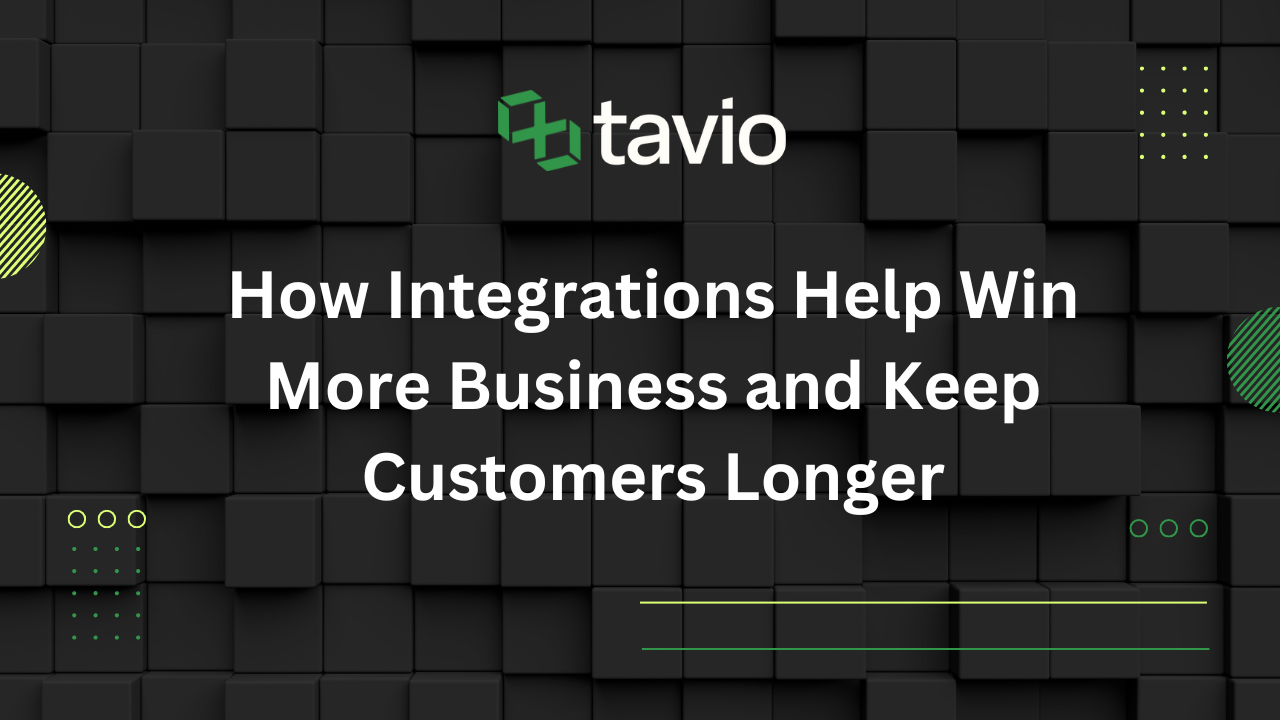
How Integrations Help Win More Business and Keep Customers Longer
Software buyers want outcomes, not homework. They expect your product to fit into their stack with minimal friction, and they judge the buying experience by how quickly they can see value. Integrations, done well, reduce friction in sales, unlock value faster after go-live, and create the kind of embedded usage that improves retention over time.
This piece explains how integrations drive competitive advantage and loyalty, then shows how Tavio’s approach helps vendors operationalize that strategy.
Why integrations are a sales differentiator
Modern buyers evaluate fit across their entire toolchain. In Salesforce’s State of the Connected Customer, 85 percent of customers said they expect consistent interactions across departments, which is only possible when systems are connected and data is shared. That expectation now shows up in vendor shortlists and RFPs.
Yet most organizations are still under-connected. MuleSoft’s Connectivity Benchmark indicates that the average company runs hundreds of applications, but only about 28 percent are connected. When data and processes are fragmented, adoption slows and the value story gets harder to prove during the deal cycle.
For vendors, making integrations part of the value proposition lowers perceived risk and shortens time to first value. Tavio’s model supports this by separating how integrations are built from how they are deployed. Developers use Tavio Studio to build and scale complex integrations with full control over APIs, while Tavio Hub gives business teams a no-code way to distribute, configure, and monitor those integrations across accounts.
Explore partnerships that open new channels and co-sell opportunities: Partnerships.
How integrations improve retention and lifetime value
Retention improves when products become part of the daily workflow and data flow. That kind of “stickiness” happens when systems are connected, data is synchronized, and users can accomplish their work without switching contexts or re-entering information.
Two data points to consider:
- Only around 28 percent of apps are connected on average, which means there is significant room to improve day-to-day experience by closing integration gaps (MuleSoft).
- 95 percent of IT leaders say integration issues are impeding AI adoption (MuleSoft).
Customer experience is directly tied to loyalty as well. Zendesk reports that more than half of customers will switch to a competitor after a single unsatisfactory experience, which often traces back to disconnected data and broken handoffs.
With Tavio, vendors can “build once, distribute to many.” You can create a single, configurable integration, then roll it out to hundreds of customers through the Hub, which reduces repetitive engineering work and keeps versions, visibility, and monitoring in one place. That helps scale your integration footprint while keeping support load predictable.
Show customers breadth and depth with our Connectors.
Operational benefits that strengthen your competitive moat
Integrations do more than close a deal. They compound operational advantages for your customers and your team.
- Fewer errors and less rework. When data moves automatically, teams avoid duplicate entry and reconciliation. That translates into faster cycles and fewer tickets.
- Faster onboarding and expansions. Prebuilt, configurable integrations shorten time to value for new customers and make cross-sell or upsell pathways clearer.
- Clearer insight into health and performance. Centralized monitoring in Tavio Hub gives customer-facing teams an at-a-glance read on integration health so they can act before issues affect renewals.
The cost side is real as well. Industry surveys have linked poor integration to measurable revenue impact. For example, Cleo’s 2023 State of Ecosystem Integration Report found that 99 percent of companies lose revenue due to poor integration, with more than a quarter losing between $500,000 and $1 million annually.
An expert opinion
“Integrations are not a feature, they are a strategy. Vendors that operationalize integrations win deals faster because buyers can see value in their own stack, and they keep customers longer because the product becomes part of the daily workflow. That is how you turn product fit into durable revenue.”
— Joe Weber, SVP of Sales, Tavio
Putting integrations into practice
If you are refining your integration strategy, consider these steps:
- Identify two to three high-leverage workflows your customers perform every day, then design integrations that remove manual steps and data silos in those workflows.
- Standardize on a build once, distribute many patterns. Use Tavio Studio to create a robust, configurable integration, then push it to many customers through Tavio Hub for consistent deployment, versioning, and monitoring.
- Track adoption and health as first-class metrics. Treat integration usage, data freshness, and error rates like product KPIs.
- Position integrations in the value story. Many buyers expect connected experiences across departments, which you can credibly address by highlighting your integration roadmap and proof points (Salesforce).
If you would like to start winning more business and keeping customers longer, connect with the experts at Tavio today.
